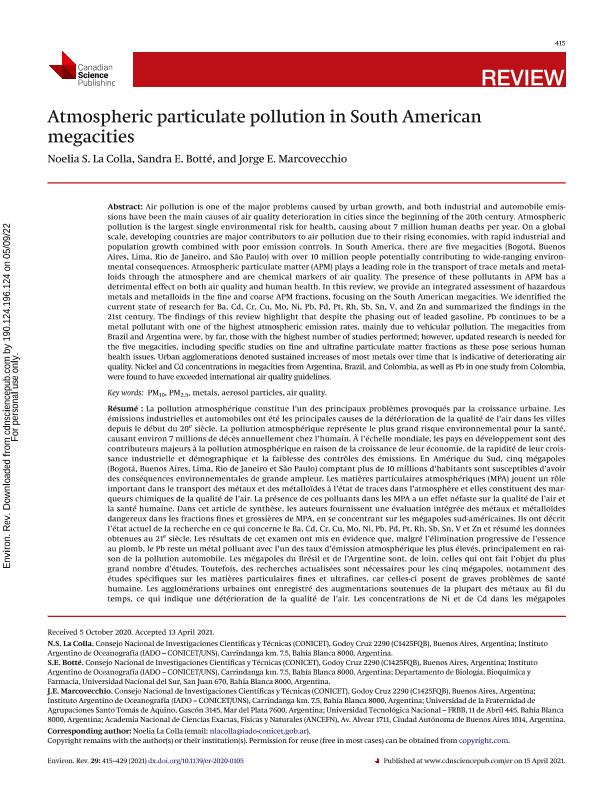Mostrar el registro sencillo del ítem
dc.contributor.author
la Colla, Noelia Soledad

dc.contributor.author
Botté, Sandra Elizabeth

dc.contributor.author
Marcovecchio, Jorge Eduardo

dc.date.available
2022-05-09T16:10:02Z
dc.date.issued
2021-04-15
dc.identifier.citation
la Colla, Noelia Soledad; Botté, Sandra Elizabeth; Marcovecchio, Jorge Eduardo; Atmospheric particulate pollution in South American megacities; National Research Council Canada-NRC Research Press; Environmental Reviews; 29; 15-4-2021; 415 - 429
dc.identifier.issn
1181-8700
dc.identifier.uri
http://hdl.handle.net/11336/156939
dc.description.abstract
Air pollution is one of the major problems caused by urban growth, and both industrial and automobile emissions have been the main causes of air quality deterioration in cities since the beginning of the 20th century. Atmospheric pollution is the largest single environmental risk for health causing about 7 million human deaths per year. On a global scale, developing countries are major contributors to air pollution due to their rising economies, with rapid industrial and population growth combined with poor emission controls. In South America there are five megacities (Bogotá, Buenos Aires, Lima, Rio de Janeiro and São Paulo) with over 10 million people potentially contributing to wide-ranging environmental consequences.Atmospheric particulate matter (APM) plays a leading role in the transport of trace metals and metalloids through the atmosphere and are chemical markers of air quality. The presence of these pollutants in APM has a detrimental effect on both the air quality and human health. In this review we provide an integrated assessment of hazardous metals and metalloids in the fine and coarse APM fractions, focusing on the South American megacities. We identified the current state of research for Ba, Cd, Cr, Cu, Mo, Ni, Pb, Pd, Pt, Rh, Sb, Sn, V and Zn, and summarized the findings in the 21st century. The findings of this review highlighted that despite the phasing out of leaded gasoline, Pb continues to be a metal pollutant with one of the highest atmospheric emission rates, mainly due to vehicular pollution. The megacities from Brazil and Argentina were, by far, those with the highest number of studies performed. However, updated research is needed for the five megacities, including specific studies on fine and ultrafine particulate matter fractions as these pose serious human health issues. Urban agglomerations denoted sustained increases of most metals over time that is indicative of deteriorating air quality. Nickel and Cd concentrations in megacities from Argentina, Brazil and Colombia, as well as Pb in one study from Colombia, were found to have exceeded international air quality guidelines.
dc.format
application/pdf
dc.language.iso
eng
dc.publisher
National Research Council Canada-NRC Research Press

dc.rights
info:eu-repo/semantics/openAccess
dc.rights.uri
https://creativecommons.org/licenses/by-nc-sa/2.5/ar/
dc.subject
PM10
dc.subject
PM2,5
dc.subject
AIR QUALITY
dc.subject
METALS
dc.subject
AEROSOL PARTICLES
dc.subject.classification
Meteorología y Ciencias Atmosféricas

dc.subject.classification
Ciencias de la Tierra y relacionadas con el Medio Ambiente

dc.subject.classification
CIENCIAS NATURALES Y EXACTAS

dc.title
Atmospheric particulate pollution in South American megacities
dc.type
info:eu-repo/semantics/article
dc.type
info:ar-repo/semantics/artículo
dc.type
info:eu-repo/semantics/publishedVersion
dc.date.updated
2022-04-21T17:11:11Z
dc.journal.number
29
dc.journal.pagination
415 - 429
dc.journal.pais
Canadá

dc.journal.ciudad
Otawa
dc.description.fil
Fil: la Colla, Noelia Soledad. Consejo Nacional de Investigaciones Científicas y Técnicas. Centro Científico Tecnológico Conicet - Bahía Blanca. Instituto Argentino de Oceanografía. Universidad Nacional del Sur. Instituto Argentino de Oceanografía; Argentina
dc.description.fil
Fil: Botté, Sandra Elizabeth. Consejo Nacional de Investigaciones Científicas y Técnicas. Centro Científico Tecnológico Conicet - Bahía Blanca. Instituto Argentino de Oceanografía. Universidad Nacional del Sur. Instituto Argentino de Oceanografía; Argentina. Universidad Nacional del Sur. Departamento de Biología, Bioquímica y Farmacia; Argentina
dc.description.fil
Fil: Marcovecchio, Jorge Eduardo. Consejo Nacional de Investigaciones Científicas y Técnicas. Centro Científico Tecnológico Conicet - Bahía Blanca. Instituto Argentino de Oceanografía. Universidad Nacional del Sur. Instituto Argentino de Oceanografía; Argentina. Universidad Tecnológica Nacional. Facultad Regional Bahía Blanca; Argentina
dc.journal.title
Environmental Reviews

dc.relation.alternativeid
info:eu-repo/semantics/altIdentifier/url/https://cdnsciencepub.com/doi/10.1139/er-2020-0105
dc.relation.alternativeid
info:eu-repo/semantics/altIdentifier/doi/http://dx.doi.org/10.1139/er-2020-0105
Archivos asociados
